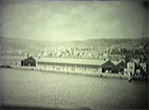The short film (11 minutes) "The Land of Israel" (AKA "The Wedding") was made during the 1930s. Following the tradition of the travelogue, the film focuses on events and places that took place in pre-state Israel during a visit that lasted a few months. The footage has no voice-over to accompany the visual, but the traveler's authoritative official tone and his emphases are present through the captions, that divide the photographed pilgrimage into a few chapters, each one dealing with a different place or event. Among them are: We Enter Haifa Port; Jerusalem: A Panorama of the Old City; A Wedding in the Holy City; and Wilderness of the Desert. The black and white images with their hallucinatory quality produce an interesting mélange of reality and dream, while the images themselves are occasionally in a dialogue with the existing imagery of the Holy Land as a primordial landscape, especially those of Jerusalem and the desert (see for example the drawings of David Robert).
Travel and cinema have a long history, dating back to the late nineteenth century, to the very inception of the cinematic medium. Travel developed as an intrinsic form of cinema, consonant with common expressions and coinings such as "travelling shot" which has to do with shooting within a movement, and the term "motion picture" itself. While film and photography were developed in tandem with industrialized modes of transportation (trains, automobiles etc.) the journey became one of cinema's most popular tropes (see Jeffrey Ruoff, 2006). From The Arrival of a Train at la Ciotat (Lumière Brothers, 1885) and The Voyage to the Moon (Georges Méliès, 1902) to Description of a Struggle (Chris Marker, 1960), La Bas (English title Down There, Chantal Akerman, 2006) and The Band's Visit (Eran Kolirin, 2007) the journey has been developed not only as a genre that was produced by the grand studios, but also as a tool for documentation and expression by independent filmmakers and individuals who made travelogues, home-movies, and filmed diaries, using non-professional equipment. In this sense, "The Land of Israel" is an early and rare example of such a documentation. But despite the individual quality of this production, it seems that the film is produced in line with the norms of the nonfiction films of its period, as well as the Zionist movement. Thus it creates an account in which the objective "voice of truth" (Roland Barthes, 1970) of his journey prevails, while dealing with "the Land of Israel" as part of the "grand narrative" of return.
Following Zali Gurevitch, we may observe two types of time: the "big time" of Jewish tradition and history, and the "small time" of the everyday. The "Israeli present," says Gurevitch, "resists the present, denies the everyday. Not that there is no everyday: there is a routine, [...] but as a cultural articulation or experience it remains open, like a book which refuses to be finished." (2007: 84, my translation). Interestingly, the short film focuses mainly on events and occurrences that belong to the "big time" of Jewish holidays and pre-state Israel, such as the Festival of Purim in Tel Aviv; the Tu Bishvat holiday; and Succoth. In this context, human figures and faces are present in the film most of the time as part of the "big events:" that of the wedding, the Purim festivity, and the announcing of the start of the Sabbath in a Jerusalem street. However, some other moments emerge along the traditional "big time" - those depicting daily life, which also include some local faces: the women bathing in the Dead Sea, seen from a distance, and the smiling faces of two young religious boys from Mea She'arim that will reappear thirty years later both in the film made by a French director Chris Marker
Interestingly, the filmmaker did not sign his name in the film. All we know is that he was a Hebrew Union College rabbinical student whose family name was Green.
